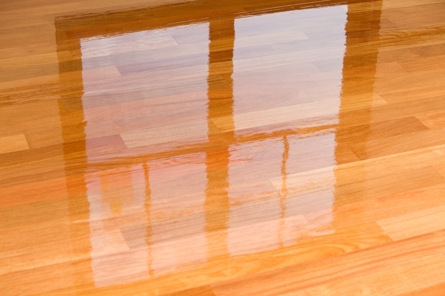Hardwood floors add timeless elegance and warmth to any home but require diligent care to maintain their beauty and integrity. Water damage, whether from a sudden leak or prolonged exposure to moisture, is among the greatest risks to hardwood flooring. If left unaddressed, it can result in costly repairs and even compromise the structural integrity of your home.
This guide will walk you through the signs, causes, and prevention of water damage to hardwood floors. With help from ServiceMaster Restoration by FUSON, you'll also learn the critical steps to take when damage occurs and when it's time to call professional help.
How to Spot Water Damage in Hardwood Floors
Spotting damage early can save you from expensive repairs. Keep an eye out for these key indicators of water damage on your hardwood floors:
Cupping or Crowning: When planks bulge up at the edges (cupping) or center (crowning), moisture is likely the culprit.
Discoloration or Stains: Dark spots or patches can indicate water exposure or mold growth.
Warping or Buckling: If sections of your floor lift or detach from the subfloor, immediate action is needed.
Unusual Odors: A musty smell often signals trapped moisture or mildew beneath the floorboards.
You may also notice cracks or gaps between boards, loose or noisy boards, or mold and mildew growth on the surface. If you observe any of these signs, taking action immediately is essential to prevent further damage.
Common Causes of Hardwood Floor Water Damage
Understanding the root causes of water damage can help prevent it from happening. Common sources include:
Plumbing Leaks: Burst pipes or leaking fixtures often affect floors near kitchens, bathrooms, or laundry rooms.
Spills and Accidents: If left unaddressed, everyday spills can seep into hardwood over time.
Humidity and Condensation: High indoor humidity or condensation from AC units can settle onto floors, causing gradual damage.
Flooding: Natural disasters like heavy rains or flash floods can flood homes and wreak havoc on hardwood.
While spilled water cleaned up immediately may not cause significant damage, prolonged exposure to moisture can weaken the wood and lead to more severe issues.
How to Prevent Hardwood Floor Water Damage
Preventative measures are the best way to protect your hardwood floors. Here are some practical tips to minimize the risk of damage:
Protect Against Spills and Leaks
Wipe up spills as soon as they occur to prevent moisture from seeping through cracks and causing hidden damage to your hardwood floors. Regularly inspecting your home’s plumbing, especially around appliances and pipes, is crucial in identifying and addressing leaks early, reducing the risk of long-term water damage.
Control Humidity Levels
Use a dehumidifier to maintain indoor humidity between 30% and 50%, which helps prevent issues like warping and cupping your hardwood floors. Additionally, installing proper ventilation in areas such as bathrooms, kitchens, and basements is essential to minimize moisture buildup and protect your floors from potential damage.
Apply Protective Coatings
Seal your floors with water-resistant sealants to protect against spills and humidity, extending the life of your hardwood. Use floor mats or rugs near entryways to prevent water from being tracked in, reducing the risk of damage over time.
What to Do if Water Gets on Your Hardwood Flooring
Even with the best precautions, flooding and other large-scale water damage can happen instantly. In these situations, it's crucial to act quickly and follow these steps:
Shut off the Water: If the source of the water is a leak or burst pipe, turn off your home's main water supply.
Remove Standing Water: Use a mop, towels, or a wet/dry vacuum to remove excess water immediately. Avoid letting water sit, as it can seep deep into the wood.
Dry Thoroughly: Use fans, dehumidifiers, or open windows to dry the room as much as possible. Avoid applying heat (like from a heater or hairdryer), as too much heat can warp the wood. If damage extends beneath the boards, consider lifting them to address moisture trapped below.
Clean and Inspect: After drying, clean the area with a mild disinfectant to prevent mold and mildew from setting in. Keep monitoring for signs of further damage, like buckling or discoloration.
If the damage is severe or unclear, contact a professional water damage restoration company like ServiceMaster Restoration by FUSON. Experts have the tools and skills to assess the damage, dry and clean the area, and repair your hardwood floors to restore them properly.
Restore Your Hardwood Floors
Water damage can seriously challenge the longevity and appearance of your hardwood floors, but with the right knowledge and action plan, you can safeguard them. Regular maintenance, quick responses to moisture issues, and timely professional intervention lead to better outcomes.
If your hardwood floors have taken damage along with other areas of your home, ServiceMaster Restoration by FUSON offers comprehensive water damage restoration services to help restore your property to its pre-loss condition.
Contact us today to request a quote or service from our experienced team!

